https://collin13.weebly.com/liberty-boys-sons-of-liberty.htm
http://www.gpb.org/georgiastories/stories/liberty_boys
https://www.britannica.com/biography/Paul-Revere
https://en.wikipedia.org/wiki/Paul_Revere
https://en.wikipedia.org/wiki/Green_Dragon_Tavern
LA VITA
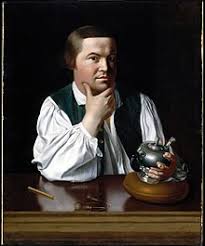
Paul Revere
Paul Revere nacque nel 1735 a Boston e fu il terzo di dodici figli. Suo padre era Apollos Rivoire, un ugonotto francese giunto in età giovanile a Boston, dove era stato istruito dall’argentiere John Coney. In seguito aprì una sua bottega e anglicizzò il suo cognome in Revere; inoltre si sposò con Deborah Hitchborn, membra di una famiglia benestante di Boston. Quando Paul ebbe tredici anni dovette lasciare la scuola ed entrare nella bottega del padre come apprendista, ma nel 1754 il padre morì e Paul non era abbastanza grande da poter condurre la bottega di famiglia. Così nel 1756, per via delle sue precarie condizioni economiche, si arruolò nella milizia e venne assegnato a Fort William Henry come sottufficiale d’artiglieria. Ma non restò a lungo nell’esercito: l’anno seguente tornò a Boston, prese il controllo della bottega del padre, dove lavorò per quasi tutta la sua esistenza, e si sposò con Sarah Orne, da cui ebbe otto figli.
I SONS OF LIBERTY E LA MECCANICA
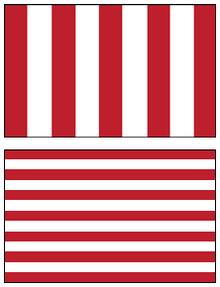
La bandiera dei Liberty Sons
Nel 1765 i suoi guadagni cominciarono a diminuire a causa dello Stamp Act, una legge imposta dalla Madrepatria che imponeva alle colonie dell’America Settentrionale di pagare una tassa su ogni foglio stampato, incluse le carte di bordo, i documenti legali, le licenze, i giornali e tutte le altre pubblicazioni: i soldi raccolti con questa tassazione erano destinati a coprire le spese militari sostenute durante la Guerra dei sette anni. Come conseguenza, nelle colonie americane vennero a crearsi diverse società segrete che intendevano opporsi alle decisioni prese dagli Inglesi, tra di esse spicca la Meccanica, formata dai Sons of Liberty (Figli della Libertà), cui aderì Revere. Infatti, il 16 dicembre 1773, egli partecipò al Boston Tea Party, una forma di protesta al Tea Act (una legge che permetteva alla Compagnia delle Indie Orientali di vendere il tè a prezzi più bassi rispetto a quelli dei contrabbandieri nelle colonie), durante la quale, nel porto di Boston, alcuni Sons of Liberty, travestiti da pellerossa, assalirono una nave inglese che trasportava tè e ne gettarono il carico in mare.
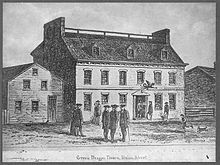
La Green Dragon Tavern
La Meccanica divenne in seguito la prima rete di intelligence americana. Infatti, sebbene lo Stamp Act fu abrogato in seguito alle proteste coloniali nel 1766, alcuni Sons of Liberty continuarono a organizzare la resistenza all’autorità della Corona e a raccogliere informazioni su attività e movimenti britannici. Questo gruppo comprendeva circa trenta patrioti, principalmente artigiani come lo stesso Revere, che si alternavano durante il giorno e la notte per osservare i movimenti dei soldati britannici a Boston e poi si incontravano regolarmente per discutere le informazioni raccolte. Le loro pratiche di sicurezza, tuttavia, erano amatoriali: si incontravano regolarmente nello stesso posto, la Green Dragon Tavern (questo luogo era già utilizzato dalla St Andrews Lodge of Freemasons per le riunioni guidate dal Gran Maestro Joseph Warren, grande amico di Revere; inoltre il Boston Tea Party era stato programmato lì), e uno dei loro leader, Benjamin Church, era in realtà un agente britannico. Ciononostante, erano riusciti a sventare la marcia di settecento Redcoats su Concord per impadronirsi del deposito di munizioni e armi dei patrioti.
LA CAVALCATA NOTTURNA
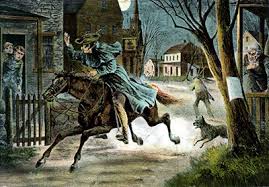
La cavalcata notturna verso Lexington
La sera del 18 aprile 1775, Paul Revere fu convocato alla Green Dragon Tavern da Joseph Warren, uno dei leader della Rivoluzione, che gli affidò il compito di andare a Lexington, nel Massachusetts, con la notizia che le truppe regolari stavano per marciare nella campagna a nord-ovest di Boston. Secondo Warren, queste truppe avevano intenzione di arrestare Samuel Adams e John Hancock, che alloggiavano in una casa a Lexington, e poi di proseguire verso la città di Concord, per impadronirsi del deposito di munizioni dei patrioti, in cui erano contenuti polvere da sparo, armi e diversi cannoni. Revere contattò il sagrestano e lo istruì a mostrare due lanterne nella torre della chiesa di Christ Church: esse segnalavano ai coloni della vicina città di Charlestown che le truppe inglesi intendevano navigare sul fiume Charles fino Cambridge; mentre una sola lanterna segnalava che l’esercito della Corona avrebbero marciato via terra. Revere quindi si fermò a casa sua per prendere gli stivali e il soprabito, e poi proseguì fino al North End di Boston, dove due amici lo attendevano per accompagnarlo attraverso il fiume fino a Charlestown. Egli però si rese conto che i remi della scialuppa che sarebbe servita per la traversata facevano troppo rumore, rischiando così di essere individuato dalle navi inglesi che controllavano il fiume. Fu salvato da una giovane donna che passava di lì per caso e che donò ai ribelli la propria sottana per fasciare i remi e attutirne il rumore. In questo modo riuscirono ad attraversare il fiume senza essere notati, complice anche l’oscurità, e giungere a Charlestown. Dopo aver informato i Sons of Liberty locali dei recenti eventi a Boston, Revere prese in prestito un cavallo da un mercante della città e intorno alle undici partì alla volta di Lexington. Dopo aver evitato la cattura appena fuori Charlestown, Revere fu costretto a cambiare il percorso pianificato per evitare le truppe inglesi, raggiungendo così la sua meta poco dopo la mezzanotte. Circa mezz’ora dopo, William Dawes arrivò a Lexington con lo stesso messaggio di Revere. A quel punto decisero di proseguire insieme fino a Concord per avvertire i coloni dell’imminente arrivo delle truppe inglesi. A poca distanza da Lexington, furono raggiunti da Samuel Prescott, che era stato incaricato di recapitare il loro stesso messaggio. Poco dopo una pattuglia britannica intercettò tutti e tre gli uomini e tentò di fermarli. Revere venne catturato e interrogato, ma fu rilasciato qualche ora dopo. Tuttavia, il suo cavallo venne confiscato per sostituire il cavallo stanco di un sergente britannico, perciò, impossibilitato nel proseguire verso Concord, tornò a Lexington a piedi per mantenere Hancock e Adams informati dei movimenti delle truppe britanniche. Dawes e Prescott invece riuscirono a fuggire e continuarono la loro cavalcata, ma solo Prescott raggiunse Concord e allertò i patrioti. In questo modo, quando il giorno dopo le giubbe rosse guidate dal generale Thomas Gage risalirono i sentieri dell’interno fino a Lexington l’effetto-sorpresa era svanito, e i patrioti poterono fronteggiarli a viso aperto. Sebbene essi alla fine furono sconfitti, questa battaglia venne ritenuta molto importante perché per la prima volta i coloni si erano uniti contro un nemico comune: la Madrepatria.
GLI ULTIMI ANNI
Negli anni immediatamente successivi, a Paul Revere venne affidato il comando della guarnigione di Fort Williams destinata al controllo del porto di Boston. In seguito partecipò alla fallimentare spedizione a Majabigwaduce nell’estate del 1779 come comandante dell’artiglieria, ma durante le operazioni militari si comportò spesso da codardo, ignorò più volte gli ordini del comandante della spedizione e non seppe utilizzare la sua artiglieria per fornire un concreto appoggio alla fanteria dello Stato della Baia del Massachusetts, impegnata nell’assedio di Fort George. Al suo ritorno a Boston fu sollevato da qualsiasi incarico militare e si ritirò a vita privata, continuando a lavorare come argentiere. Morì nel 1818 a Boston.
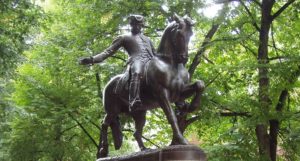
Statua di Paul Revere
THE LIFE
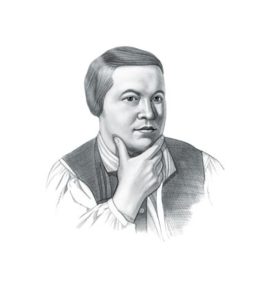
Paul Revere
Paul Revere was born in Boston in 1735 and was the third of twelve children; his father, Apollos Rivoire, was a French Huguenot who came to Boston when he was young. He worked with the silversmith John Coney, changed his surname in Revere and then bought his own silver shop and married Deborah Hitchborn. When Paul was thirteen he left school and became an apprentice to his father, a silversmith. But then his father dead, so in 1756, he enlisted in the provincial army. Possibly he made this decision because of the weak economy, since army service promised consistent pay. The next year he married Sarah Orne and they had eight children.
SONS OF LIBERTY AND THE MECHANIC

The Liberty Sons’ flag
Revere became the owner of the father’s silver shop, but his business began to suffer when the British economy entered a recession in the years following the Seven Years’ War, and declined further in 1765 because of the Stamp Act ( it was an Act of the Parliament of Great Britain that imposed a direct tax on the British colonies and plantations in America and required that many printed materials in the colonies be produced on stamped paper produced in London. Printed materials included legal documents, magazines, playing cards, newspapers, and many other types of paper used throughout the colonies). So in this year was formed a group of militants, who would become known as the “Sons of Liberty”, of which Revere was member.
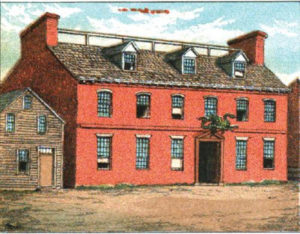
The Green Dragon Tavern
In 1773 the merchant ship Dartmouth arrived in Boston harbor carrying the first shipment of tea made under the terms of the Tea Act. This act authorized the British East India Company to ship tea directly to the colonies, bypassing colonial merchants. Passage of the act prompted calls for renewed protests against the tea shipments. Revere took part in the Boston Tea Party of December 16, when colonists, disguised as Indians, dumped tea from the Dartmouth and two other ships into the harbor. Then, in order to watch over the British troops’ movements, Revere and a group of thirty Patriots made up the Mechanics, that was the first American intelligence service. They frequently took turns, two and two, to watch the British soldiers by patrolling the streets all night. But they met regularly and always in the same place, the Green Dragon Tavern (it was already used by the St. Andrews Lodge of Freemasons for their meeting led by Grand Master Joseph Warren, a Revere’s close frend; also the Boston Tea Party was planned there), to discuss their information: because of this, they didn’t understand that one of their leader, Benjamin Church, was a British spy.
THE MIDNIGHT RIDE
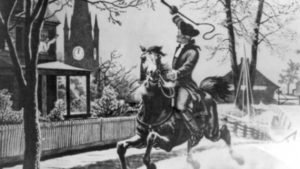
The Midnight Ride
During 1775, British troops received instructions to disarm the rebels, who were known to have hidden weapons in Concord, and to imprison the rebellion’s leaders, especially Samuel Adams and John Hancock, who lived in Lexington. So, between 9 and 10 p.m. on the night of April 18, 1775, Joseph Warren, a political opposition leader, at the Green Dragon Tavern told Revere that the king’s troops were about to embark in boats from Boston bound for Cambridge and the road to Lexington and Concord. Warren suggested that the most likely objectives of the regulars’ movements later that night would be the capture of Adams and Hancock, so Revere was sent out to warn them and to alert colonial militias in nearby towns. Revere instructed the sexton of the North Church to send a signal by lantern to alert colonists in Charlestown as to the movements of the troops: one lantern in the steeple would signal the army’s choice of the land route, while two lanterns would signal the route by water across the Charles River. That night, Revere first gave instructions to send the signal to Charlestown: the movements would ultimately take the water route, and therefore two lanterns were placed in the steeple. He then crossed the Charles River by rowboat, slipping past a British warship, and safely landed in Charlestown. There he bought a horse from a merchant and rode to Lexington. Revere arrived in Lexington around midnight, and William Dawes, who carried the same information, arrived about a half-hour later. They met with Samuel Adams and John Hancock and they time discussing plans of action upon receiving the news. Then Revere and Dawes continued along the road to Concord, accompanied by Samuel Prescott, to warn Patriots, but they were detained by a British Army patrol. Revere was captured and questioned by the British soldiers. He told them of the army’s movement from Boston, and that British army troops would be in some danger if they approached Lexington, because of the large number of hostile militia gathered there. He and other captives taken by the patrol were still escorted east toward Lexington, until about a half mile from Lexington they heard a gunshot. The British major demanded Revere explain the gunfire, and Revere replied it was a signal to “alarm the country”. As the group drew closer to Lexington, the town bell began to clang rapidly and the town was alarmed. So the British soldiers decided not to press further towards Lexington but instead to free the prisoners and head back to warn their commanders. Revere was free and he walked back to Hancock and Adams’ house to keep them apprised of the proximity of British force. In the meantime, Prescott, who had escaped from the British army, reached Concord and warned the Patriots. Thank to this, the next day Patriots were able to fight with British troops. They didn’t win, but this battle was very important because enveloped a common sense and joined all the colonists.
THE LAST YEARS
The British in June 1779 established a new base on Penobscot Bay. Massachusetts authorities called out the militia and organized a major expedition to dislodge the British. The expedition was a complete fiasco: its land and naval commanders squabbled over control of the expedition, and could not agree on strategy or tactics. The arrival of British reinforcements led to the destruction of the entire Massachusetts fleet. Revere commanded the artillery units for the expedition, and was responsible for organizing the artillery train. But he disobeyed orders of Brigadier General Solomon Lovell and didn’t help the colonists during the siege of Fort George. So, when he returned to Boston, he was exonerated from every military service. Revere continued to work as a silversmith and dead in 1818.
ARTICOLO REDATTO DALL’ALUNNA MASSERANO IRENE DELLA CLASSE IV A DEL LICEO CLASSICO SOTTO LA SUPERVISIONE DELLA PROF. ORIANA MAFFEO E DEL PROF. MARCO CASTELLI


Commenti recenti